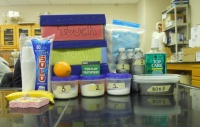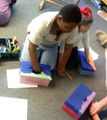Mystery Senses
| Instant wiki maker | Making handouts | Editing tips |
Biology In Elementary Schools is a Saint Michael's College student project from a course that ran between 2007 and 2010 and fully described in this book chapter. The student-created resources have been preserved here for posterity. Link under 'toolbox' for printer-friendly versions of the exercises. Click on handouts to print full resolution versions. Please see Wikieducator's disclaimer, our safety statement, and the Creative Commons licensing in English and in legalese.
Student worthiness
Tried once and worked well
Primary biological content area covered
This experiment will require students to use their sense of touch, hearing, smell, and taste in order to properly identify the senses. It will enable students to see how well the senses work independently from one another.
Materials
- Materials Required for the Teacher's use:
- roll of duct tape
- toothpicks
- 1 bag cotton balls
- 2 oranges cut into slices
- bottle of vinegar
- bottle of mouthwash
- handful of pennies
- couple handfuls of sand
- 3 pieces of fabric (fabric book covers work great)
- 3 shoe boxes with holes cut in the top
- 3 containers to hold salt, sugar, and flour
- 3 empty water bottles
- flour
- sugar
- salt
- water
- one banana
- Materials That Each Individual Student Would Need:
- drawing packet (see 'Our Packet' below in Handouts section)
- crayons or markers
- small paper cups filled with water
Description of activity
This activity gives kids 'hands-on' experience testing their senses. They get to learn about their senses through a variety of tests at different stations. Not only are the students experimenting and learning about senses, but they also get the chance to draw and read about them as well.
Handouts
- Our Packet
Lesson plan
- Teacher Preparation Beforehand:
- Create booklets for children to draw their predictions in (sample shown above 'Our Packet' in Handouts section).
- Take 3 shoeboxes and cut a hole in the center on the top. Attach a "curtain" made of fabric of some sort so it is not possible to see through the hole. Label boxes clearly: Box 1, Box 2, and Box 3.
- Create Station 1 by taking the boxes and setting them side by side. Place handful of cotton balls inside of Box 1. Place a banana inside of Box 2. Place a sponge inside of Box 3.
- Create Station 2 by placing 3 containers side by side. Label containers clearly: Container 1, Container 2, and Container 3. Soak a handful of cotton balls in mouthwash and place them in Container 1. Soak a handful of cotton balls in vinegar and place them in Container 2. Place cut up orange slices in Container 3.
- Create Station 3 by duct-taping 3 water bottles so they are completely covered. Students should not be able to see into the water bottles at all. Label water bottles clearly: Bottle 1, Bottle 2, and Bottle 3. Pour some sand into Bottle 1. Pour water into Bottle 2. Place a handful of pennies inside Bottle 3.
- Create Station 4 by pouring some salt, sugar, and flour in separate containers labeled 1, 2, and 3. Lay out toothpicks near containers. Pour water in small paper cups in order for children to rinse their mouths out after tasting.
- Set up each Station in different sections of the room.
- Student Experiment:
- Explain to students there are 4 different stations they are going to do activities in. Split students into groups and lead them to Station 1 where the 3 boxes are set up. Tell them this station will focus on their sense of touch. Have the students stick their arm through the hole in the box and feel what the object is without looking. Have students draw their predictions as to what each object is in the appropriate box in their booklet.
- Lead children to Station 2. Tell them this station will focus on their sense of smell. Tell students each box contains a certain smell. Have students take time to smell inside the box. Have students circle what they think the smell is in the appropriate space in their booklets (the smell page should have a list of possible choices as to what the smell could be).
- Lead children to Station 3. Tell them this station will focus on their sense of hearing. Tell students each covered water bottle contains certain objects (pennies, water, or sand). Have students take time to shake each bottle and listen to the sound it makes. Have students draw their predictions as to what is in each bottle in the appropriate box in their booklet.
- Lead children to Station 4. Tell them this station will focus on their sense of taste. Tell students each container contains different tastes. Have students take toothpicks and wet the tips to try each taste. Have students circle what they think they taste in the appropriate space in their booklets (the taste page should have a list of possible choices as to what the substance could be).
- Ask students if they have any questions about their senses and go over the 'mystery' objects with them. Have a discussion with the students and inquire what each experiment was for. Ask what they learned by using their senses.
- Student Experiment Photos
Potential pitfalls
The teacher should be sure that no student is allergic to any elements used in this experiment.
Art connections
Students will use their senses to draw a prediction of what each object is.
Literature connections
Cole, Joanna & Degen, Bruce. The Magic School Bus Explores the Senses. New York: Scholastic Press, 2001. Print.
McMillan, Bruce. Sense Suspense. New York: Scholastic Press, 1994. Print.
- These 2 books (especially Sense Suspense) would be good ones to read after the students participate in the 'Mystery Senses' experiment. Students will find the reading much more interesting after exploring their senses themselves.
Connections to educational standards
GLE: S(3-4):2: Students demonstrate their understanding of the scientific method by predicting and hypothesizing
GLE: S(3-4):5: Students demonstrate their ability to represent data by organizing a collection of data into a table or a graph template.
GLE: S(3-4):41: Students demonstrate their understanding by showing how external body structures help them survive; relating the external to the internal body structures.
7.14-b: Students demonstrate understanding of the human body — heredity, body systems, and individual development — and understand the impact of the environment on the human body. This is evident when students: Identify the parts of the human body, and demonstrate understanding of how the parts work together to perform functions that satisfy common needs.
Next steps
After completing this activity, it is recommended the teacher gather the students and ask them what they guessed at each station. It is important to go over the results so students feel a sense of completion. It might also be helpful to talk about what senses are easier to use compared to others that are harder to rely on by themselves (when asked this question, most students said touch was the easiest sense to rely on, whereas smell was harder). If enough time is available, teachers should connect the student's experiment to literature by reading one of the two books listed below. This will allow students to think further about their senses and will enable them to ask more questions.
Reflections
Justine - This experiment turned out to be a popular "experiment station" for the students, and they enjoyed it. It did take a while to set-up, so if you're planning this experiment in a classroom it is very important to factor in 10-15 minutes for set-up time. Once set-up was complete, things ran smoothly; we were able to introduce our experiment to the students and ask them questions about the senses before they began. Many students knew what senses were and could name all 5. This made it easy for us to seg-way them into each of the stations. In 25 minutes there was enough time for students to explore each station and make predictions. There was also approximately 5 minutes left at the end, enabling us to gather all the students and ask them what they thought each object was, as well as show them inside the boxes and containers. Students loved trying to guess what was at each station. Because they were so excited, it was hard to keep them from shouting out their guesses and ruining it for other students near them. We realized early on it was important to let the students know to keep their guesses to themselves until the end. Another 'issue' we had to fix in the beginning of the experiment was the container with orange slices in it. Students were able to see the orange peels through the top, so we had to cover the peels with cotton balls so it wasn't so easy for them. Another thing to keep in mind: We had a "multiple choice" option for 2 sections in the packet we made. We did this because we knew students would not be able to draw the difference between salt, sugar, and baking soda. This made it easy for students to look and copy one another's papers, and it also made it so students did not draw in the other 2 sections. They simply wrote the word "banana" instead of actually drawing the banana, for example. This took away the "art" connection we intended for our experiment. Overall, however, I believe this experiment worked out very well, and students had a good time learning how to use their senses. I would definitely use this experiment in my future classroom.
Neil – This experiment was very successful and entertaining for the kids. It worked so well because it was very hands on and kept the kids moving so they never become bored with the subject matter. The setup time was a slight issue with the first group because of the time it took to get completely prepared. But luckily we only had to set up once for the first group so it was not a problem for any of the other groups. I was surprised how easily they could identify the objects in the touch boxes. It seemed that only 1 or 2 out of the 60 children we worked with had to take a little extra time to figure out what they were feeling. I also was really happy to see how excited the kids would get when they thought they knew what they were feeling. I was expecting them to get happy and proud that they figured out what was in the box but some of them got the biggest smiles on their faces just because they knew what was inside of the box. I do think one of the weaknesses of this experiment was its lack of artistic connection. Though there was some art connection in two of the stations it would be nice to somehow, if even possible, get all the stations to have a strong art connection. All in all I feel like this experiment worked very well. The kids really enjoyed it and it kept them focused and cooperative, I would definitely recommend this experiment to others.
Citations and links
Lesson Plan: Sensorama by Michelle Curtiss
All images in figures 3-6 from http://commons.wikimedia.org













